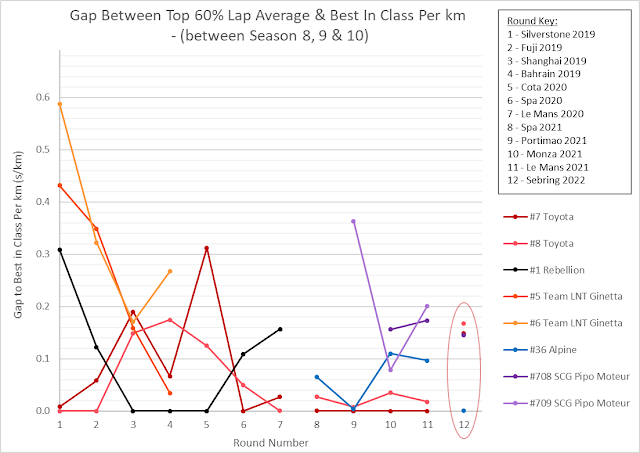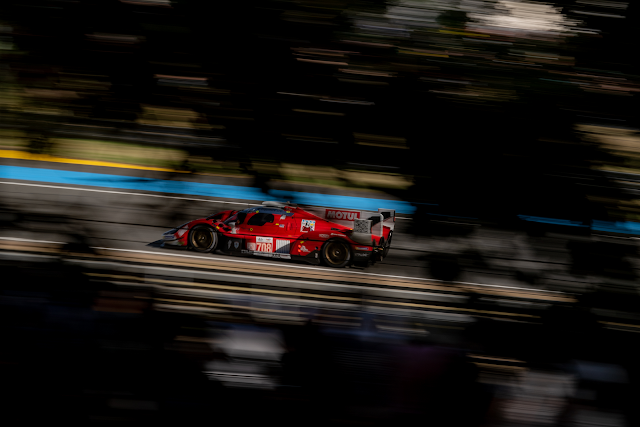Sebring saw a heavy-handed shift in Balance of Performance, something still rather new to the top class of the world championship. Despite seeing some races with remarkably similar average lap times, the previous season only one chassis winning races, the Toyota GR010, highlighting how poor over a race distance the system was implemented.
Previously we have explored why this is happening, how the Alpine cannot fit the fuel energy it is given in the BoP in the car, and proposed options for the series to improve the racing. So, how did Alpine turn it around with such a win?!
BoP Baseline Changes
It appeared leading up to the race that these calls for action from last season were heeded; Toyota had their GR010s with 30kg added, and 11MegaJoules removed from the stint energy allowance since last season as the baseline Balance of Performance. But much more importantly their hybrid system couldn’t be deployed below 190kph – previously it was 120kph (in dry and 150 for wet tyre running). This parameter is now subject to adjustment as a BoP parameter.
This rendered their complex Hybrid system only usable at the end of straights rather than their historical significance punching out of corners with tremendous power, and aiding stability correcting any cornering oversteer. This also sends more load through the rear tyres, reducing their wear advantage over the Rear Wheel Drive competition.
In addition, the LMP1 Alpine is running at minimum weight, has reduced power output and with that, has a corresponding energy per stint allowance. This brings it closer to the fuel tank capacity meaning the stint length penalty Alpine had last year should be reduced (the car can get closer to it’s theoretical ideal stint in the BoP calculations).
Stint Lengths
First, we’ll interrogate these stint lengths and how much time the LMP1 car would have to make up. Did Alpine stop more than the Toyota this time? Well, yes and no!
If we ignore the emergency service under Safety Car for the #8 then yes, the #36 did require one more conventional pit stop.
For the Sebring pit lane this resulted in an average pit time for the #36 of 81 seconds, and therefore an 81 second ‘penalty’ to overcome with pace on track if the race was fully green.
In duration terms, the #8 could do on average 52:25 average stint lengths, nearly 5 minutes more than the #36 Alpine (47:43 average). The SCG007 did an average of 50:58 (for full stints removing short stints making the most of yellows).
For a green-flagged conventional 6h WEC race this stint length would require 7 normal stops for the Alpine and half a tank extra. The GR010 can do 7 with no splash in the last hour but the SCG may need some fuel saving to reach the flag with 7.
Pace Gaps
To overcome the fuel tank deficit above, the BoP needed to have Alpine clearly as the fastest car. How much faster was it?

Using the Top 60% of best laps as the averaging window (the measurement in the BoP process), Alpine were ~1 second faster than the LMH cars sharing the class. It also highlights how well the hybrid and non-hybrid LMHs were balanced on pace; 0.02 seconds between the #708 and the #7 for their top 60% laps (although #7 had a smaller sample size of laps).
By showing their top laps sorted in order, you can visualise the pace gaps in Hypercar. The #8 was very consistent with a flatter curve, a good sign for Le Mans. Having Glickenhaus as consistent as Alpine was a pleasant surprise, they’re getting more from their package after the updates over the winter.
Because of the #7 crash it has ~half the sample size of laps, so no wonder it has a steeper gradient, but going with the top 60% average, it was the faster Toyota (the top 60% laps of the #8 in the same time window was a tenth slower).In Historical Context - Comparing To 2021
In the past I have described a way to even out circuit differences to show how cars and BoP compare round by round, by working out the top 60% average lap time, measuring the gaps from that to the best in class, and then normalising that by circuit length. Putting this data side-by-side over the previous seasons it gives more context.
For Sebring it shows the tables were turned compared to last season’s Toyota pace dominance, but also that the gaps on track were made bigger between the LMH and LMP1 chassis. The gaps between the different LMH chassis has never been this close however, a good sign for balancing multiple chassis designed to the same performance window. Did someone say LMDh?!
Alpine Fuel Tank Penalty Analysis/Comments
As discussed above the two main factors mostly pre-determined for the balance of LMP1 in Hypercar are the pace differences on track and the fuel energy/stint length. Below shows how the factors compared to each other at Sebring over normal green flag running:
- On average, the #36 Alpine was ~0.15 seconds faster per km distance travelled than Toyota and Glickenhaus (who themselves were closely matched).
- For each km driven in a stint, the #36 Alpine on average spent ~0.08 seconds more servicing the car than the rival #8 mainly due to the fuel tank being smaller and having to refuel more (1 more stop if you remove the #8 emergency service stop)
Therefore, the discrepancy between the pit stop losses we saw last season (between LMP1 and LMH) was finally overturned by faster pace on track! It is however ~2 times too big of an on-track pace advantage, so this time a different manufacturer was running away with it!
Also, if there was a late intervention which reset the stints between the LMH cars and the Alpine, the P1 would drive away without having the pit lane penalty holding back the pace advantage.
The organisers have proven they can overcome the differences in LMP1 and LMH homologated cars, they can therefore learn and implement BoP adjustments to converge closer as the season goes on. I hope this BoP is updated before the next round, such that the Alpine is ~0.6 seconds faster on average over a lap of Spa Francorchamps (7.004km). This should give an equalised theoretical lap time/fuel tank ratio (for lack of a better term!). (This does not consider the difference in pit lane length between Sebring and Spa Francorchamps, it is a rough estimate.)
The circuit characteristics of the next round at Spa Francorchamps will also potentially help; Spa is a higher speed circuit, so the opportunity to use the capped Hybrid deployment (over 190kph) is wider.
To see these changes however and their effects, we’ll just have to wait…
What does this kind of thing mean over 24H?
To translate the numbers and coefficients into something more manageable, let’s apply this to Le Mans with some assumptions. Alpine’s stint average of 49 minutes, and #8’s 52.5 minutes, spread over 24h the Alpine would stop ~31 times and the GR010 ~28 times. For a pit time of ~75 seconds at Le Mans (from 2021 data of the #36) that equates to a penalty of just over a lap.
On pure pace (with hypothetical equal pit stops) using a finger in the air of the distance record (5410km) and the 0.15s/km gap, there would be a gap of ~4 laps after 24 hours with this BoP…
Adding the two factors together would lead to a #36 win of ~2 laps. This really highlights how much Toyota were held back at Sebring!








Comments
Post a Comment